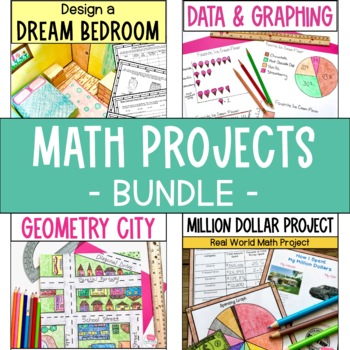Math Projects - 4th and 5th Grade - Area, Perimeter, Angles, Graphing, Decimals
- Zip
What educators are saying
Products in this Bundle (4)
Description
Your 4th and 5th grade students will love working on the engaging math projects included in this bundle! Use these real world math projects as end of unit activities, alternative ways to assess student learning, or fun ways to integrate math and art.
You save 20% off the price of the individual resources when you purchase this bundle!
Click the PREVIEW button to see more details of what is included.
Projects Included in This Bundle:
⭐ Design a Dream Bedroom - students will apply the skills of area, perimeter, surface area and scale factor as they design a floor plan for their dream bedroom and build a 3d model.
⭐ Data and Graphing Project - students will choose a survey question, collect data analyze data, calculate the data landmarks and create four graphs to display their data. This project also includes an extension about misleading data and graphs.
⭐ Geometry City Project - students will follow a set of guidelines about types of angles and types of lines to create their own city. Includes an editable set of directions and editable rubric so you can adjust the angle and line requirements to match your standards.
⭐ Million Dollar Project - students will work with a set of required purchases and spending categories as they spend a budget of one million dollars. Includes tracking spending and graphing the amount of money spent in different categories.
Math projects are a great way to:
- encourage creativity
- differentiate learning
- integrate math and art
- assess student learning (that is not a paper and pencil test)
- apply math skills to real world situations
- provide structured, educational fun!
You May Also Like:
Design a Food Truck PBL project
Create a Popsicle Cart PBL Project
Follow me and be notified when new products are added to my store.
New products are always 50% off for the first 24 hours they are posted!
Thanks!
- Dawn





